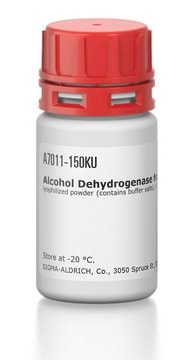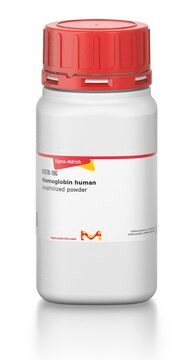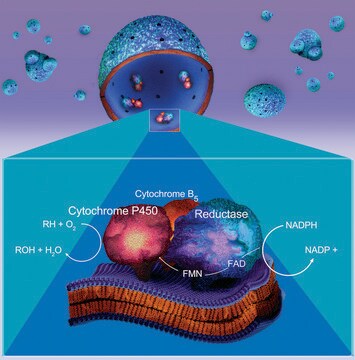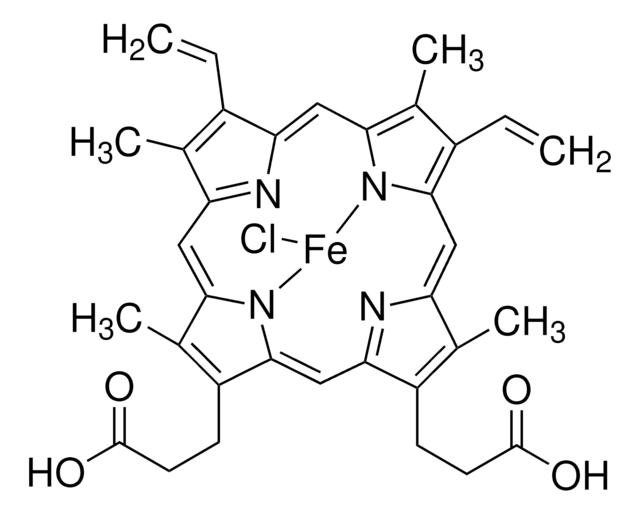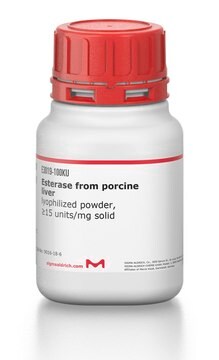F8649
Formate Dehydrogenase from Candida boidinii
lyophilized powder, 5.0-15.0 units/mg protein
Sinonimo/i:
FDH, Formate:NAD+ oxidoreductase
Autenticatiper visualizzare i prezzi riservati alla tua organizzazione & contrattuali
About This Item
Prodotti consigliati
Origine biologica
fungus (Candida boidinii)
Stato
lyophilized powder
Attività specifica
5.0-15.0 units/mg protein
Composizione
Protein, 5.0-20.0% biuret
Temperatura di conservazione
2-8°C
Cerchi prodotti simili? Visita Guida al confronto tra prodotti
Applicazioni
Formate Dehydrogenase (FDH) is used for diagnostics in large scale industrial processes. Its used in the production of an unnatural amino acid, tert-L-leucine, a component of some HIV protease and matrix metalloprotease inhibitors.
Azioni biochim/fisiol
Formate dehydrogenase is an abundant enzyme from yeast Candida boidinii (CbFDH) that plays an important role in the energy supply of methylotrophic microorganisms and in the stress response of plants.
Formate dehydrogenase is involved in the stress response of plants and catalyzes the reduction of NAD+ to NADH.
Definizione di unità
One unit will oxidize 1.0 μmole of formate to CO2 per min in the presence of β-NAD at pH 7.6 at 37 °C.
Avvertenze
Danger
Indicazioni di pericolo
Consigli di prudenza
Classi di pericolo
Resp. Sens. 1
Codice della classe di stoccaggio
11 - Combustible Solids
Classe di pericolosità dell'acqua (WGK)
WGK 3
Punto d’infiammabilità (°F)
Not applicable
Punto d’infiammabilità (°C)
Not applicable
Dispositivi di protezione individuale
Eyeshields, Gloves, type N95 (US)
Scegli una delle versioni più recenti:
Possiedi già questo prodotto?
I documenti relativi ai prodotti acquistati recentemente sono disponibili nell’Archivio dei documenti.
I clienti hanno visto anche
Held in police custody.
A Skelt
Nursing times, 84(4), 50-52 (1988-01-02)
Jana Löwe et al.
Scientific reports, 8(1), 10436-10436 (2018-07-12)
A biotechnological process is reported, which enables an enzymatic reduction without the need for addition of an organic co-substrate for in situ-cofactor recycling. The process is based on merging the fields of enzymatic reductive amination with formate dehydrogenase-based in situ-cofactor
Frances L Shaw et al.
Journal of bacteriology, 194(15), 3814-3823 (2012-05-23)
The food-borne bacterial pathogen Campylobacter jejuni efficiently utilizes organic acids such as lactate and formate for energy production. Formate is rapidly metabolized via the activity of the multisubunit formate dehydrogenase (FDH) enzyme, of which the FdhA subunit is predicted to
Yutaka Amao et al.
Faraday discussions, 155, 289-296 (2012-04-05)
Solar fuels, such as hydrogen gas produced from water and methanol produced from carbon dioxide reduction by artificial photosynthesis, have received considerable attention. In natural leaves the photosynthetic proteins are well-organized in the thylakoid membrane. To develop an artificial leaf
Mark Pryjma et al.
Journal of bacteriology, 194(15), 3803-3813 (2012-05-29)
Campylobacter jejuni is a food-borne bacterial pathogen that colonizes the intestinal tract and causes severe gastroenteritis. Interaction with host epithelial cells is thought to enhance severity of disease, and the ability of C. jejuni to modulate its metabolism in different
Il team dei nostri ricercatori vanta grande esperienza in tutte le aree della ricerca quali Life Science, scienza dei materiali, sintesi chimica, cromatografia, discipline analitiche, ecc..
Contatta l'Assistenza Tecnica.
